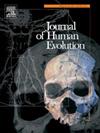中国晚中新世粗壮猿新认识:解剖学、系统学和古生物学
IF 3.1
1区 地球科学
Q1 ANTHROPOLOGY
引用次数: 0
摘要
结实长猿(Laccopithecus robustus)是中国云南石惠坝晚中新世的上古猿之一。它可以追溯到~ 7-6 Ma,是欧亚大陆已知的最后一种存活的上石器类动物。关于长猿颅齿材料的初步报告已经发表,但没有详细的形态学描述。目前的研究提出了一个更完整的描述头盖骨,下颌骨,和牙列的拉科古猿;提供与其他上齿类的比较;并强调了该属的显著特征。拉索古猿是一种相对较大的上齿类动物,估计体重为10-11公斤,与现存的连趾猴相似。一组牙齿突触将拉古猿与其他crouzeliid的上猿类联系起来,在这些中,拉古猿被推断与特化的近猿类crouzeliids(即Egarapithecus和Anapithecus)关系最密切。尽管拉科古猿将这些一般特征与几个独特的特征(即相对较小的眼眶、发育不全的眶上缘、较深的下脸、单一的眶下孔和可能相对较早收敛的明显的颞线)结合起来,但对拉科古猿颅骨的比较突出了在上猿类中颅骨结构的显著相似性。与现存的卡他鼻类动物相比,长猿犬体型的性别二型性相对较高,这与相对较低的估计体重二型性相结合。在一些现存的古猿中也可以看到类似的模式,可能在原始猿中也有。在饮食行为方面,基于相对剪切峰发育,长猿和大多数上猿一样,似乎以果食性为主。先前归属于Laccopithecus的一个孤立的部分手指骨可能属于当代sivaladapids, Sinoadapis carnosus。本文章由计算机程序翻译,如有差异,请以英文原文为准。
A new look at Laccopithecus robustus from the Late Miocene of China: Anatomy, systematics, and paleobiology
Laccopithecus robustus, from the Late Miocene of Shihuiba in Yunnan Province of southwestern China, is one of the best known pliopithecoids. Dating to ∼7–6 Ma, it is the last-known surviving pliopithecoid in Eurasia. Preliminary reports of the craniodental material of Laccopithecus have been published, but no detailed accounts of the morphology are available. The current study presents a fuller description of the cranium, mandible, and dentition of Laccopithecus; provides comparisons with other pliopithecoids; and highlights the distinguishing features of the genus. Laccopithecus is a relatively large pliopithecoid, with an estimated body mass of 10–11 kg, similar in size to the extant siamang, Symphalangus syndactylus. A suite of dental synapomorphies links Laccopithecus with other crouzeliid pliopithecoids, and among these, Laccopithecus is inferred to be most closely related to the specialized anapithecine crouzeliids (i.e., Egarapithecus and Anapithecus). Comparisons of the Laccopithecus cranium highlight the remarkable similarity in the cranial bauplan among pliopithecoids, even though Laccopithecus combines these general features with several unique specializations (i.e., relatively small orbits, weakly developed supraorbital rims, deep lower face, a single infraorbital foramen, and marked temporal lines that probably converged relatively anteriorly). Sexual dimorphism of canine size in Laccopithecus is moderately high compared with that in extant catarrhines, and this occurs in conjunction with relatively low levels of estimated body mass dimorphism. A similar pattern is seen in some extant colobines, and possibly also in Anapithecus. In terms of dietary behavior, based on relative shearing crest development, Laccopithecus, like the majority of pliopithecoids, appears to have been predominantly frugivorous. An isolated partial manual phalanx, previously attributed to Laccopithecus, may possibly belong instead to the contemporary sivaladapid, Sinoadapis carnosus.
求助全文
通过发布文献求助,成功后即可免费获取论文全文。
去求助
来源期刊

Journal of Human Evolution
生物-进化生物学
CiteScore
6.30
自引率
15.60%
发文量
104
审稿时长
3 months
期刊介绍:
The Journal of Human Evolution concentrates on publishing the highest quality papers covering all aspects of human evolution. The central focus is aimed jointly at paleoanthropological work, covering human and primate fossils, and at comparative studies of living species, including both morphological and molecular evidence. These include descriptions of new discoveries, interpretative analyses of new and previously described material, and assessments of the phylogeny and paleobiology of primate species. Submissions should address issues and questions of broad interest in paleoanthropology.
 求助内容:
求助内容: 应助结果提醒方式:
应助结果提醒方式:


